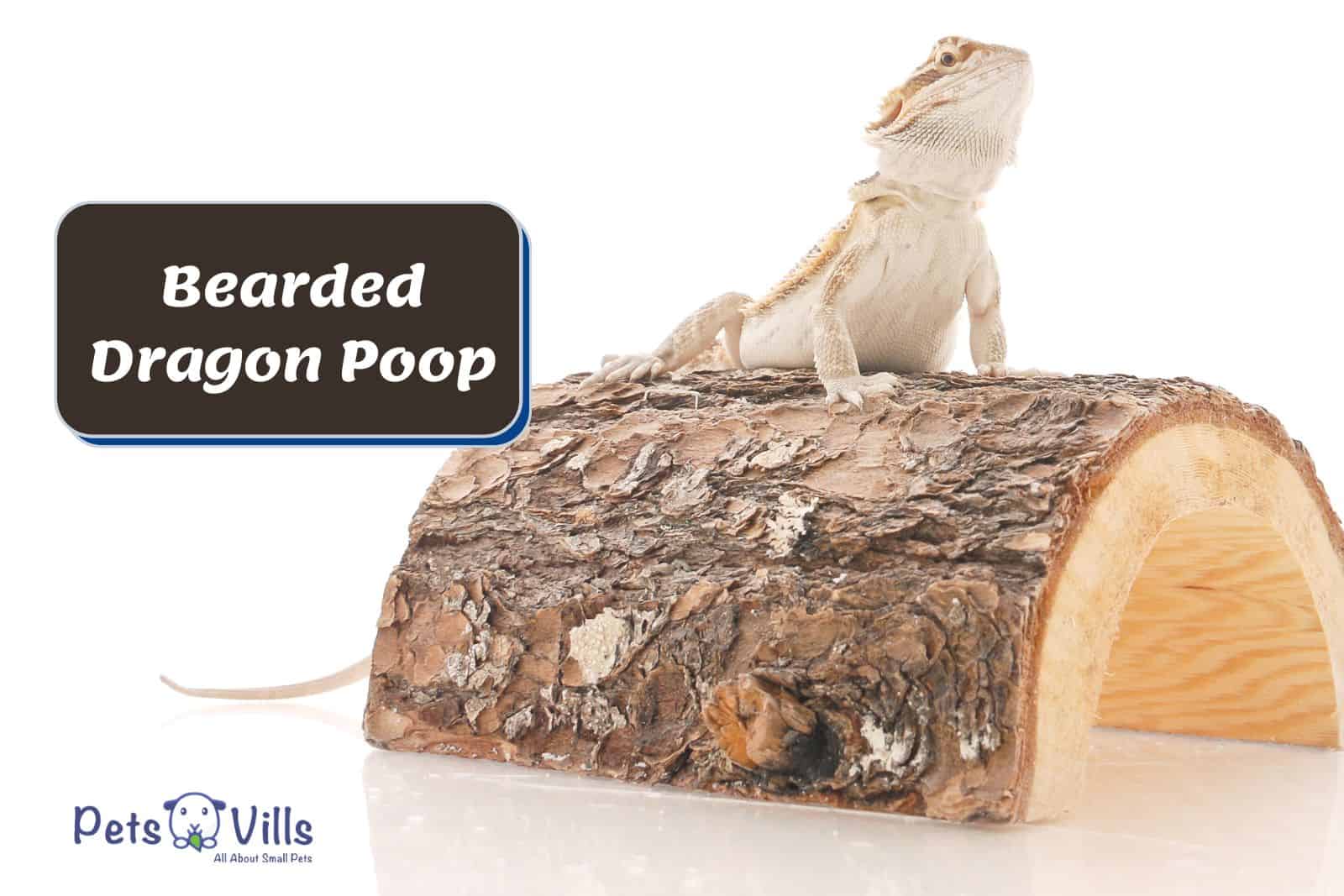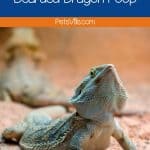The other day, during my cleaning, I happened to pass by Bobby’s tank and noticed the bearded dragon poop.
At first, with my concentration on the dusty surfaces, I continued with the cleaning but stepped back to the tank setup.
I had not seen poop with so much green color before, so I went into panic mode and called my local reptile expert.
Here is what I learned about the Pogona Vitticeps poop, and I hope this table gives you a quick insight into the reptile poop issue.
| Color | Cause | Need to Worry? |
| Green poop | Dominant after eating green vegetables. | No. |
| Yellow poop | Excessive consumption of calcium. | No, but reduce calcium supplement intake. |
| Chalky white poop | Signs of dehydration. | Yes, but ensure the pet stays hydrated. |
| Blood-stained/ red poop | Dominant after eating red foods. Sign of parasites and impaction. | No. Yes, soak in warm water with a gentle massage or have the pet checked. |
| White & brown poop | Normal poop color. | No. |
| Black poop | Excessive consumption of insects. | Reduce the insect-based diet. Schedule a vet visit if not on an insect diet. |
Table of Contents
What Does Healthy Bearded Dragon Poop Look Like?
Ideally, a healthy bearded dragon poop looks brownish with a whitish coloration. The poop should appear firm and give no foul smell.
A fact to note, the chalky white paste coloration is called urate, and it is the dragon’s form of peeing. Moreover, it can come as a yellowish substance, so do not panic seeing the color change.
Also, note that this color can be affected by the choice of tank lining you have if ingested, so invest in the best substrate for bearded dragons. Here is a list of the normal poop coloration.
Green Poop
A green coloration on a dragon’s poop is not a significant issue to be worried about. This is because the adult beardies’ diet primarily consists of leafy greens and fewer insects.
The green coloration is caused by chlorophyll, a dominant green dye in greens. After feeding the animal greens like bell peppers, collard greens, kale, and spinach, you will note this color.
White and Brown
This is the standard poop color you can expect your pet lizard to produce. If your beardie produces such waste, you are doing a proper husbandry job.
Red Poop
If your pet lizard recently indulged in a meal containing red leafy vegetables, a red stool is inevitable. Red foods you can feed your scaly friend include red bell peppers, beets, cabbage, raspberries, and melons.
How do you know if the poop indicates a health issue? Let’s take a look.
What Does Unhealthy Bearded Dragons Poop Look Like?
As you may know, the color of a bearded dragon’s poop can show its health. That said, understanding what abnormal poop looks like is essential.
Here is a list of abnormal poop colors.
Green
While a green stool can indicate a healthy dragon; there are instances where it shows opposite findings. For example, if your adult bearded dragon gives out a green runny poop emitting a foul smell, it is not healthy.
In such a case, You should collect and take a fecal sample to your local vet for a physical examination. The probable cause for this can be a parasitic or bacterial infection like Salmonella warranting emergency medical care. (1)
White
What causes white poop in bearded dragons? Ideally, the answer lies in the pet’s hydration levels. Fortunately, this is an issue you can solve without needing a reptile expert.
So make time in your busy schedule to bathe your dragon at least three times weekly in warm water. The water should not be deep, so use a shallow dish to do this job.
And as a rule of thumb, invest in a hygrometer to measure the tank’s humidity levels and ensure the reading averages 35%-40%.
From time to time, you can mist the enclosure to maintain humidity levels but take care not to moisten the loose particle substrate, encouraging bacterial growth.
Red
While red-colored feces have a possibility of indicating good health; they can also show health issues.
Ideally, if you note your dragon has a bloody stool, it could be they have ingested a foreign object. Or better yet, they ate an insect with sharp leg spikes.
This can also happen if you use loose substrate on the terrarium setup instead of choosing non-particle substrates like a reptile carpet or ceramic tiles.
And the chances are that this foreign object has hurt the pet’s gastrointestinal tract causing bleeding.
After seeing red poop on the enclosure, the best approach is to keep a close eye on the dragon. If the redness does not go away within a few days, have a vet do blood tests for parasites.
Yellow
Calcium is one of the primary nutritional elements needed for the survival of a bearded dragon. However, it is easy to overdo this supplement and end up causing health issues like liver disease. (2)
Moreover, the diet is not the only cause of calcium overload since the UVB light can affect the pet if it reaches the entire tank. Cut calcium-rich foods like kales or check the UVB bulb setup.
Also, know that male bearded dragons produce a yellowish discharge called a seminal plug. It is usually a build-up of sperm in their ducts, and you do not have to worry.
Female adult beardies also produce slugs, primarily infertile eggs with a yellow discharge.
Black
A black poop from your bearded dragon indicates you have a diet excessively inclined to insects, resulting in severe constipation.
Ideally, you will have to cut on the insect supply and increase the vegetable intake for your adult bearded dragons.
And if you have a baby beardie, since its diet comprises 80% insects and 20 % vegetables, reduce the number of insects per feeding.
In the case of a black watery poop, your animal companion could be dealing with a parasitic infection, and it is best to seek vet care.
Also, note that a beardies poop darkens over time, so this should not be a significant cause of stress. Ideally, the best time to tell whether the poop is black is immediately after the animal excretes it.
In addition to the color of your pet’s poop, there are some other facts you need to know.
Check out this video!
Must Know Facts About Bearded Dragon Poop
On your pet ownership journey, you will encounter various bearded dragon poop issues and questions. This is why it is essential to know the facts surrounding this topic.
That said, here is some crucial beardies excrement facts to know.
How Often Do Bearded Dragons Poop?
Beardies’ bowel movements depend on a variety of factors like age, health conditions, their environment, and brumation. Ideally, a beardie should not go for more than a week without pooping.
And as a pet owner, you must track how the poop looks. This will help identify potential health issues threatening your pet lizard’s quality of life.
That said, a baby bearded dragon poops three times per day or at least once. Juvenile dragons poop once a day; meanwhile, adult dragons go 1-7 times weekly.
Does bearded dragon poop smell? No, your bearded dragon’s poop should not have any foul smell and if it does, seek medical care for a comprehensive fecal examination.
Do Bearded Dragons Poop During Brumation?
Every once in a while, reptiles undergo a brumation period, especially in cold temperatures. During this period, your pet will be inactive and, as a result, eat less food and stay hidden for long.
Moreover, this period can extend up to three months, so you do not have to panic if you are a new bearded dragon owner. If unsure whether your pet reptile is undergoing brumation, you can ask your local veterinarian.
How Long Can a Bearded Dragon Go Without Pooping?
A normal and healthy bearded dragon cannot go for more than a week without pooping. The exception for this bowel habit is either brumation in healthy dragons or being unhealthy.
Some reasons your beardie may experience a lack of bowel movements for a week include:
- Internal parasites.
- Stress.
- Poor appetite.
- Digestive problems.
- An improper diet.
- Lack of adequate heating.
Moreover, the frequency of bowel movements depends on the bearded dragon’s age, so observe the stage of life before panicking.
And, note that, whether you have a male vs female bearded dragon, the sex does not affect how long the animal goes without excreting.
Why is Bearded Dragon Poop Runny?
A beardie usually has runny poop or diarrhea for various reasons. Ideally, track if you recently fed the pet something new or check for any signs of stress.
Moreover, note that a beardie can have a runny poop if you recently made a significant move affecting its life.
Instances inducing stress include changing the tank’s position or the enclosure setup, and loud noise. For starters, you must keep a close eye on the bearded dragon to see if the condition goes away.
However, if it persists, schedule a vet check-up and take a fresh sample for analysis, so the vet can check for parasites or health issues. Common parasites causing diarrhea in beardies include nematodes, pinworms, protozoa, giardia, and coccidia. (2) (3) (4)
Here is a YouTube video from Animal1 guy explaining coccidia, its clinical signs, and prevention.
Why Is My Bearded Dragon Not Pooping?
As your scaly friend ages, note that their bowel movements keep reducing. So there is no need to worry after your baby dragon becomes a juvenile or adult, and you notice a reduction in its pooping frequency.
If your dragon doesn’t poop, this could be a sign of illness or stress. It is best to check with your poop monitor chart and observe your lizard closely to see if it poops.
Also, check for signs such as loss of appetite and sluggishness, provided the lizard is not brumating. And if the animal goes for a prolonged period of time without poop, have a vet check it to avoid serious health issues.
How to Get a Bearded Dragon to Poop?
At most, a constipated bearded dragon will have a challenging time pooping. However, there are various ways you can follow to help your human companion poop, and they include:
1. Bathing the Pet in Warm Water
A reptile soak takes 15-30 minutes and is a sure way to spark a bowel movement. Moreover, you should take your time to massage the pet gently along the tummy to help push the fecal waste down.
2. Use Olive Oil
This readily available oil acts as an excellent laxative in clearing your dragon’s digestive tract. To help your pet ingest the olive oil, place some drops on its nose and have them lick it.
3. Feed Soft Foods
Another way to make your dragon poop is by adding soft foods like pumpkin puree to its diet. These foods are easier to digest, and what’s more, pumpkin is a known food that aids digestion.
4. Double-Check Heat and UVB Devices
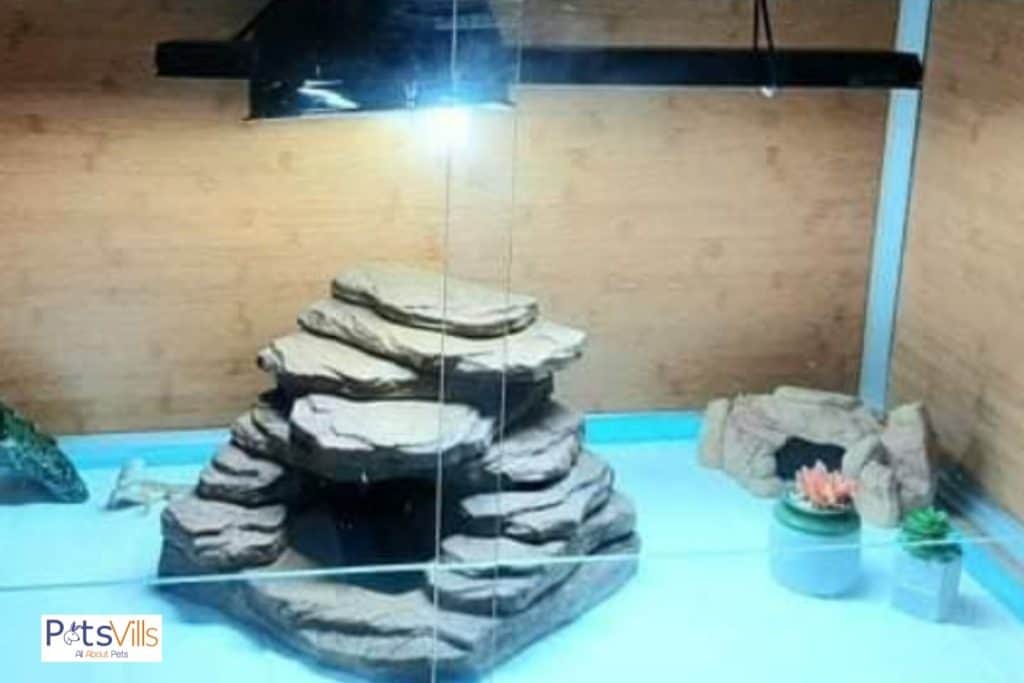
Heating helps the beardie digest their food correctly, and a poor tank setup won’t support this. Furthermore, note that the heating and UVB lighting circuits are prone to damage, so frequently check and replace the bulbs.
FAQs
Does Bearded Dragon Poop Stink?
No, a healthy dragon’s poop has no foul smell emitted from it. However, if you find out your dragon’s poop emits a foul smell, it could indicate illnesses, parasitic infections, or digestive problems.
Should Bearded Dragons’ Poop be Solid?
No, fresh bearded dragon poop usually has a moist appearance attributed to the uric acid paste excreted. However, this poop quickly dries up and hardens after exposure to air, so ideally, check on a sample of fresh poop.
Will My Bearded Dragon Poop in Brumation?
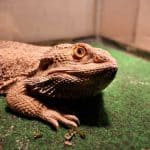
Yes, you can expect your pet reptile to poop while they hibernate, but the amount of poop won’t be the same as usual. Since the animal is inactive and in hiding, it will eat a less balanced diet and poop less.
Is Green Poop Healthy?
Yes, green poop is inevitable, especially in adult bearded dragons since their diet consists of 80% leafy greens. You only have to worry if your beardie has not eaten a vegetable diet or the poop becomes runny and stinky.
Conclusion
There you have it, reptile parents, a comprehensive guide covering the bearded dragon poop issues.
You do not have to panic anymore when you note irregularities with your dragon’s poop schedule since you now know what to do.
Moreover, you can solve some pet health issues without needing a herp vet. So I hope you found this blog post helpful and that I have answered your questions.
It is now up to you to spread the word to other pet owners with bearded dragon poop questions.
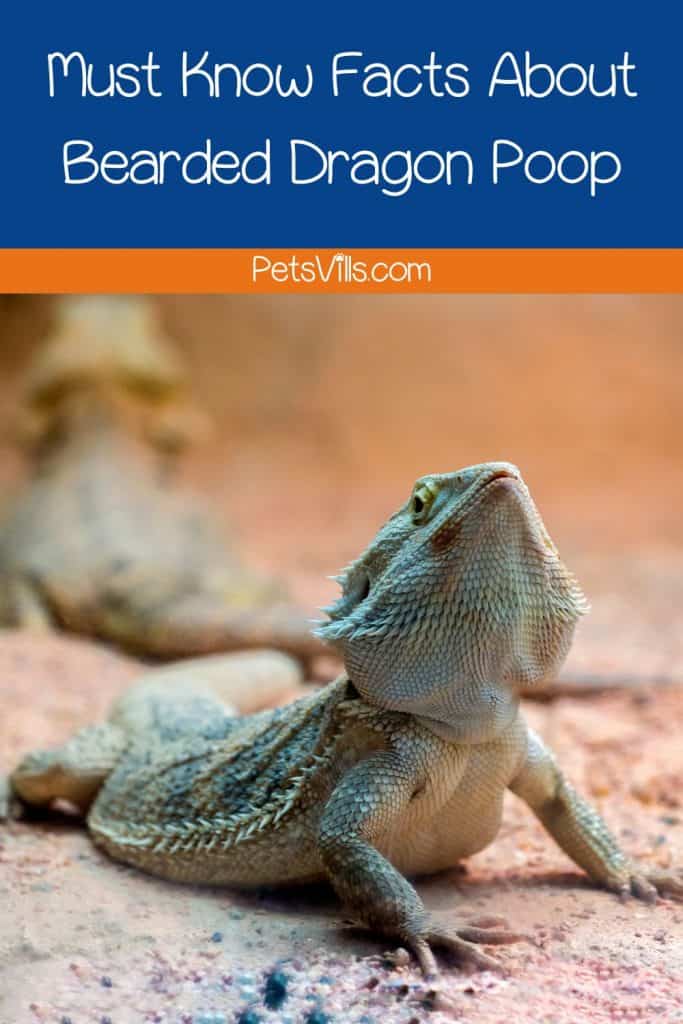
References:
- 1. CDC. CDC: Salmonella Outbreaks Linked to Pet Bearded Dragons [Internet]. Centers for Disease Control and Prevention. 2022. Available from: https://www.cdc.gov/salmonella/uganda-01-22/index.html
- 2. Paul Pion DVM, Spadafori G. Veterinary Partner. VINcom [Internet]. 2017; Available from: https://veterinarypartner.vin.com/default.aspx?pid=19239&catId=102919&id=8017925
- 3. Nematodes in Lizards – Symptoms, Causes, Diagnosis, Treatment, Recovery, Management, Cost [Internet]. wagwalking.com. Available from: https://wagwalking.com/reptile/condition/nematodes-in-lizards
- 4. Walden M, Mitchell MA. Pathogenesis of Isospora amphiboluri in Bearded Dragons (Pogona vitticeps). Animals. 2021;11:438.
Alina Hartley is a small-town girl with a ginormous love of bearded dragons. It all started with Winchester, a baby bearded who was abandoned at the shelter by his former owners because of a birth defect that caused one front leg to be shorter than the other. Alina originally went to the shelter looking for a guinea pig, but one look at Winchester and it was love at first sight. From that day on, Alina has dedicated her life to learning everything she can about bearded dragons. She loves helping new beardie parents start their incredible journey with these magnificent reptiles.
Follow her on:
LINKEDIN
TWITTER.
Read her latest articles HERE
Learn more about her HERE.

